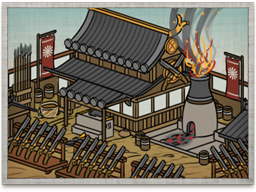Difference between revisions of "Arsenal (TWS2)"
m |
m |
||
| Line 1: | Line 1: | ||
| − | {{Building | + | {{TWS2 Building|image=[[Image:Arsenal S2TW.png]] |
|Chain=Siege Type | |Chain=Siege Type | ||
|Requires='''Buildings''':<li>[[Gunsmith (TWS2)|Gunsmith]]</li> | |Requires='''Buildings''':<li>[[Gunsmith (TWS2)|Gunsmith]]</li> | ||
Revision as of 08:31, 21 December 2011
| Arsenal (TWS2) | |
|---|---|
 | |
| Chain | Siege Type |
| Requires | Buildings: |
| Enables | Units: |
| Spawned Defence Forces | |
| Basic Building Statistics | - |
| Clan Effects | - |
| See main article; FotS Buildings | |
Description
A loaded cannon often discourages dissent.
A large store of weapons, armour and other necessaries is vital to warfare. A general worth his sword knows that his men cannot march without shoes, fight without weapons or live without food. To command warriors is meaningless unless they have what they need to carry the fight to the enemy. The arsenal allows the recruitment of rocket units. In addition, an experienced force of matchlock samurai will always be present in the province for defensive purposes. The first clan to construct an arsenal will also benefit from improved reloading times for all matchlock-carrying troops.
As the wars of the Sengoku Jidai increased in ferocity and armies increased in size, weapons and armour became less a matter of choice for individual samurai, and more of a logistical nightmare. A samurai might well provide all his own war gear, but the thousands of ashigaru being recruited into the clan armies needed everything from helmets to socks and sandals. This lead to standardisation of equipment by all clans, and a literally uniform appearance in their respective warriors. In this, the Japanese warlords were well ahead of their European contemporaries.